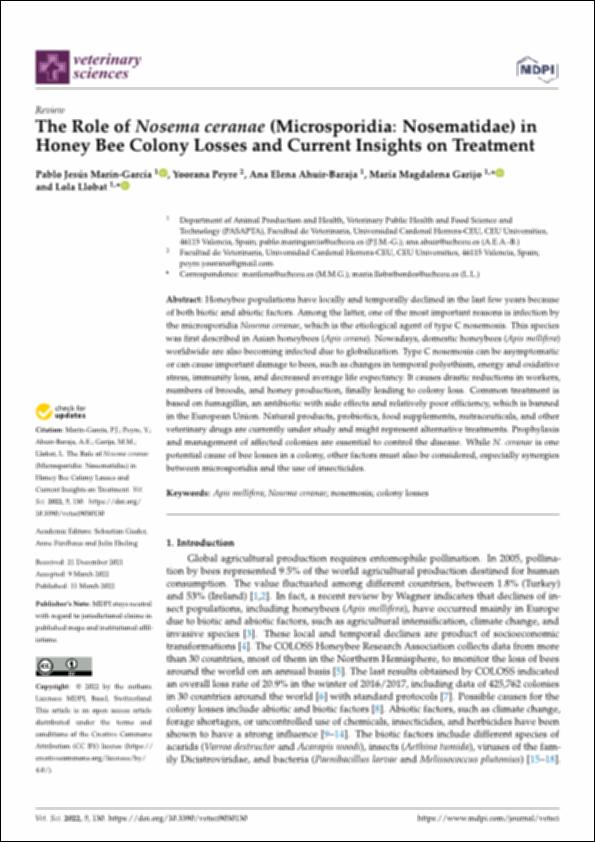Por favor, use este identificador para citar o enlazar este ítem:
http://hdl.handle.net/10637/14175The role of "Nosema ceranae" (Microsporidia: Nosematidae) in honey bee colony losses and current insights on treatment
| Título : | The role of "Nosema ceranae" (Microsporidia: Nosematidae) in honey bee colony losses and current insights on treatment |
| Autor : | Marín García, Pablo Jesús Peyre, Yoorana Ahuir Baraja, Ana Elena Garijo Toledo, María Magdalena Llobat Bordes, Lola |
| Materias: | Bees - Diseases - Treatment.; Abejas |
| Editorial : | MDPI |
| Citación : | Marín-García, P. J., Peyre, Y., Ahuir-Baraja, A. E., Garijo, M. M. & Llobat, L. (2022). The role of "Nosema ceranae" (Microsporidia: Nosematidae) in honey bee colony losses and current insights on treatment. Veterinary Sciences, vol. 9, i. 3 (11 mar.), art. 130. DOI: https://doi.org/10.3390/vetsci9030130 |
| Resumen : | Honeybee populations have locally and temporally declined in the last few years because of both biotic and abiotic factors. Among the latter, one of the most important reasons is infection by the microsporidia Nosema ceranae, which is the etiological agent of type C nosemosis. This species was first described in Asian honeybees (Apis cerana). Nowadays, domestic honeybees (Apis mellifera) worldwide are also becoming infected due to globalization. Type C nosemosis can be asymptomatic or can cause important damage to bees, such as changes in temporal polyethism, energy and oxidative stress, immunity loss, and decreased average life expectancy. It causes drastic reductions in workers, numbers of broods, and honey production, finally leading to colony loss. Common treatment is based on fumagillin, an antibiotic with side effects and relatively poor efficiency, which is banned in the European Union. Natural products, probiotics, food supplements, nutraceuticals, and other veterinary drugs are currently under study and might represent alternative treatments. Prophylaxis and management of affected colonies are essential to control the disease. While N. ceranae is one potential cause of bee losses in a colony, other factors must also be considered, especially synergies between microsporidia and the use of insecticides. |
| Descripción : | Este artículo se encuentra disponible en la siguiente URL: https://www.mdpi.com/2306-7381/9/3/130 Este artículo pertenece al número especial "Honey Bee Pathogens and Parasites". |
| URI : | http://hdl.handle.net/10637/14175 |
| Derechos: | http://creativecommons.org/licenses/by/4.0/deed.es |
| ISSN : | 2306-7381 (Electrónico) |
| Idioma: | es |
| Fecha de publicación : | 11-mar-2022 |
| Centro : | Universidad Cardenal Herrera-CEU |
| Aparece en las colecciones: | Dpto. Producción y Sanidad Animal, Salud Pública Veterinaria y Ciencia y Tecnología de los Alimentos |
Los ítems de DSpace están protegidos por copyright, con todos los derechos reservados, a menos que se indique lo contrario.


